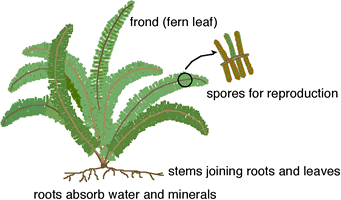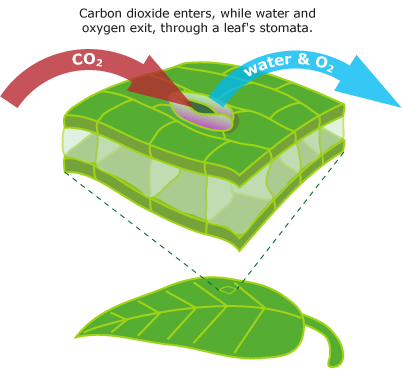
SC.912.L.14.7 Plant Structure
You need to know how the structures of plant tissues and organs are directly related to their roles in physiological processes.
-
Plant organs are limited to roots, stems, leaves, flowers, fruit, and cones.
-
Physiological processes are limited to photosynthesis, cellular respiration, transpiration, and reproduction.
-
Plant tissues are limited to meristematic, ground, dermal and vascular tissues.
-
Plant structures are limited to cambium, guard cells, phloem, seed, stomata, and xylem.
TUTORIALS
Plant Structure and Adaptations
Plant Organs
Movement of Water Through a Plant
EOC Practice Questions
The Plant Kingdom
-
Plants are eukaryotes that have cell wall containing cellulose and carry out photosynthesis using chlorophyll a and b found in in chloroplasts.
-
Plants are autotrophs (able to make their own food)
-
Plants are multicellular organisms. Like other multicellular organisms, the cells of many plants are organized into tissues and organs.

Why are plant leaves green?
Plants leaves appear green due to the photosynthetic pigments chlorophyll a and b, which are located in chloroplasts
Plants Basic Needs
All plants have the same basic needs: sunlight, a way to exchange gases with the surrounding air, and water and minerals

Types of Plants: Vascular and Nonvascular Plants
Scientists divide all plants into two large groups: bryophytes (Nonvascular plants) and tracheothytes (Vascular plants)
Plants are thought to have evolved from aquatic algae (plant like protists).

BRYOPHYTES
Nonvascular Plants
Include Mosses, liverworts, and hornworts

Characteristics of Bryophytes
-
Lack the vascular tissue for the transport of water and nutrients.
-
Live in wet or moist environments
-
Obtain the nutrients directly from their surroundings by diffusion.
-
Low lying, grow close to the ground due to the lack of the vascular tissue
-
No roots, leaves, or stems.
-
Develop spores.
-
Spores are simple reproductive bodies that can generate a new plan
TRACHEOPHYTES
Vascular Plants
Include seedless plants such as ferns and nonflowering and flowering seed plants
Seedless Plants
Non Flowering Seed Plants
Gymnosperms
Flowering Seed Plants
Angiosperms



Characteristics of Tracheophytes
-
Have vascular tissue for the transport of water and nutrients
-
Two main types of vascular tissue:
-
Xylem moves water and nutrients from the ground upward in the plant.
-
Phloem carries food made in the plant's leaves down to other plant parts
-
This transport system allows tracheophytes to grow to large sizes.
-
Have roots, stems and leaves
-
Seedless plants develop spores
-
Seed plants develop seeds.
-
Nonflowering plants, Gymnosperms have naked seeds
-
Flowering plants, Angiosperms have covered seeds
Plant Organs
Roots, stem, leaves, flowers, fruits and cones

Plant Tissues
Dermal, ground, vascular and meristematic tissue.

Xylem and Phloem

Plants have three main types of tissues:
Dermal tissue is the protective outer covering of a plant
Vascular tissue supports the plant body and transports water and nutrients throughout the plant. This tissue is composed of xylem and phloem.
Xylem transports water and dissolved minerals from roots to leaves
Phloem transports food (sugars) made in leaves during photosynthesis to all other parts of the plant
Ground tissue produces and stores sugars, and contributes to the physical support of the plant
These tissues are found within the roots, stem and leaves
Compare and Contrast How are tracheids and sieve tube elements similar? How are they different?
Both consist of long slender cells that connect almost like sections of of pipe and have openings in the walls that allow materials to move from cell to cell.
Thracheids in xylem carry water and die as they mature.
Sieve tube elements in phloem carry nutrients (sugars) produced in the leaves during photosynthesis and are alive at maturity.

Plant Growth and Mesristem
The secret of plant growth are found in meristems. Meristem are regions of unspecialized cells in which mitosis produces new cells that are ready for differentiation. Meristems are found in places where plants grow rapidly, such as the tips of stems and roots.
Meristematic tissue contains meresitematic cells (undifferentiated cells). The undifferentiated cells they produce are very much like the stem cells of animals.
Meristematic cells give rise to various organs of the plant like leaves, flowers, and keep the plant growing.
Meristematic tissue is found in the following locations:
-
Near tips of roots and stems (Apical meristem causes primary growth, lenghtening of plants)
-
In the buds and nodes of stems.
-
In the vascular cambium between the xylem and phloem . Lateral meristem causes secondary growth, widening of the plant)
All these are rapidly growing regions.
Vascular cambium is a layer of actively dividing meristematic cells that produces xylem and phloem
Apical Meristem


The apical meristem produces a hormone called auxin. Auxin inhibits the growth of the lateral buds.
If the apical meristem is cut off the plant gets bushier
Vascular Cambium makes Xylem and Phloem



Roots Are Organs
-
Roots anchor and support the plant
-
Absorb water and dissolved nutrients from the soil
-
Store food and water
Two types of root systems in plants are fibrous roots and taproot

A fibrous root system does not have a single main root. Instead, many small, shallow roots branch out from the base of the plant. Plants called monocots have fibrous roots.
Advantage: Allows plants to absorb water close to the surface
A tap root system is a single root that grows deep into the soil. Smaller roots branch from the main root.
Advantage: Absorb water deep from the ground.
Store food sugars, starches and water

The surface of the roots are covered with thin projections called root hairs which produce a large surface area that allows water and minerals to enter.


The root tip is covered with a tough root cap that protects the delicate apical meristem
Leaves are the main photosynthetic organs in vascular plants.
The structure of a leaf is optimized to absorb light and carry out photosynthesis. Recall that photosynthesis is the process by which plants use sunlight to make food from carbon dioxide and water.
Leaves are WIDE and FLAT to create a large surface area and to absorb as much light as possible.
Leaves are THIN so that the sunlight can get to the chloroplasts in the cells.
Leaves have tiny holes called stomata on their underside through which gases needed for photosynthesis are exchanged ( gases move in and out).

The waxy cuticle is a waterproof barrier that protects tissues and limits the loss of water through evaporation
The palisade mesophyll contains closely packed cells in one layer that absorb light that enters the leaf
The spongy mesophyll has many air spaces between its cells. These air spaces connect with the exterior through stomata.
Stomata are small openings in the epidermis that allow carbon dioxide, water and oxygen to diffuse into and out of the leaf.

Guard cells are highly specialized cells that surround the stomata and control their opening and closing.
Guard cells regulate the movement of gases into and out of leaf tissues.

Differences Between Guard Cells and the Surrounding Epithelial Cells.


Leaves Adaptations
Pitcher Plant: The leaf of a pitcher plant is modified to attract and then digest insects and other small prey as their source of nitrogen

Spruce: The narrow leaves (needle-shaped) of spruce contain a waxy epidermis as well as stomata that are sunken below the surface of the leaf. These adaptations reduce water loss from the leaves.

Rain Forest Plants: Tend to have broad, float leaves, which absorb as much light as possible in shady conditions.

Living Stone: the two leaves of a living stone are adapted for hot, dry conditions period, they are rounded, which minimizes the exposure of their surface to the air. They also have very few stomata.

Cactus: Cactus leaves are actually non-photosynthetic thorns that protect against carnivores. Most cacti have microscopic leaves which help prevent water loss. Most plant photosynthesis is carried out in its stem.

Venus Flytrap: It has sensory receptors on its leaves. When an insect touches a receptor, the leaf snaps shut, trapping the insect.
